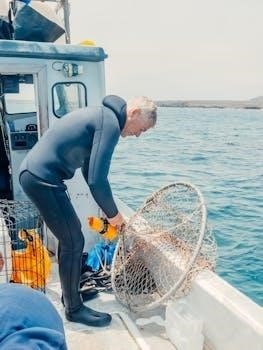
scuba diving wetsuit thickness guide
Selecting the correct wetsuit thickness is crucial for scuba diving comfort and safety. Wetsuits, primarily made of neoprene, provide thermal insulation. Thickness ranges from 1mm to 9mm, with common options like 3mm, 5mm, and 7mm, depending on water temperature and activity.
Understanding the Importance of Wetsuit Thickness
Wetsuit thickness plays a vital role in maintaining a diver’s body temperature, which is paramount for a safe and enjoyable dive. The primary function of a wetsuit is to trap a thin layer of water between the suit and the skin. This water is then heated by the body, creating an insulating barrier against the colder surrounding water. The thicker the wetsuit, the greater the insulation it provides, making it suitable for cooler waters. Conversely, thinner wetsuits are ideal for warmer environments where overheating can be a concern. Choosing the appropriate thickness prevents hypothermia in cold conditions and discomfort from overheating in warmer waters. Correct wetsuit thickness enables longer and more comfortable dives, allowing for better exploration of the underwater world. Ignoring this aspect can lead to discomfort, reduced dive time, and potentially dangerous situations, highlighting the critical importance of selecting the right wetsuit thickness.
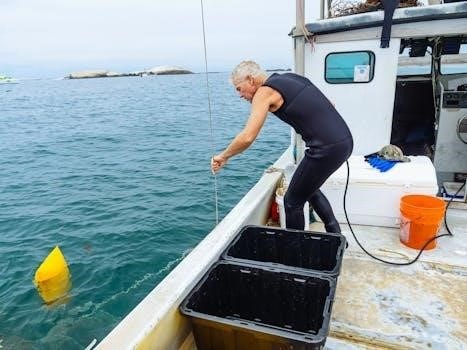
Wetsuit Thickness and Water Temperature
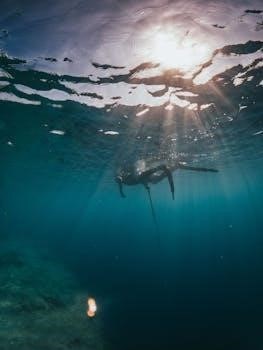
Water temperature is the primary factor in choosing a wetsuit. Warmer waters require thinner suits, while colder waters necessitate thicker options for adequate thermal protection and comfort during dives.
Tropical Waters (Above 82.4°F/28°C)
Diving in tropical waters, where temperatures exceed 82.4°F (28°C), often requires minimal thermal protection. In these conditions, a full wetsuit is typically unnecessary, and divers may opt for a simple bathing suit, a rash guard, or a thin UV-protective dive skin. These options provide enough protection from the sun and minor abrasions without causing overheating. While a 1.5mm to 3mm wetsuit or shorty might be considered by some, they are generally not needed unless the diver feels particularly cold. The primary concern in these waters is comfort and sun protection, rather than insulation. This approach allows divers to enjoy the warm waters with maximum freedom of movement and minimal bulk. Remember, comfort is key in these warmer environments.
Warm Waters (77°F ⎻ 80.6°F/25°C-27°C)
For warm waters, ranging from 77°F to 80.6°F (25°C to 27°C), a bit more consideration for thermal protection is needed, though not as extensive as in colder waters. Here, divers typically find that a 2mm shorty wetsuit or a 1mm full suit provides the ideal balance. These thinner wetsuits offer sufficient warmth for longer dives without causing excessive heat retention, ensuring comfort throughout the dive. Some divers who tend to feel cold easily might still prefer a slightly thicker option, but generally, these thin wetsuits suffice. The choice often depends on personal preference and how long one plans to be in the water. These waters are suitable for comfortable diving with minimal thermal encumbrance.
Cool Waters (71.6°F ⎻ 75.2°F/22°C-24°C)
In cool waters, with temperatures ranging from 71.6°F to 75.2°F (22°C to 24°C), a 3mm full wetsuit is generally recommended. This thickness provides a good balance between insulation and flexibility, allowing divers to stay comfortable without feeling overly restricted. While a shorty might be suitable for very short dives or individuals who are less sensitive to cold, a full suit provides better coverage and thermal protection for extended periods underwater. The 3mm thickness is versatile, making it suitable for various diving conditions and activities within this temperature range. Divers should also consider wearing a good wetsuit top or vest for added warmth, especially during longer dives or if the weather is windy, which can further reduce body temperature.
Colder Waters (62.6°F ⎼ 69.8°F/17°C-21°C)
When diving in colder waters, with temperatures between 62.6°F and 69.8°F (17°C to 21°C), a wetsuit with a thickness of 5mm to 7mm is advisable to ensure adequate thermal protection. Divers can select either a 5mm full suit, which is often a good option for intermediate conditions, or opt for the thicker 7mm suit, which offers significantly more insulation for those more sensitive to cold. In this temperature range, it is important to choose a suit that provides sufficient warmth to prevent hypothermia and ensure a safe dive. For dives in the lower end of this temperature range, it’s wise to consider additional accessories like a hooded vest to further enhance thermal protection, particularly around the head and torso, which are critical areas for heat loss.
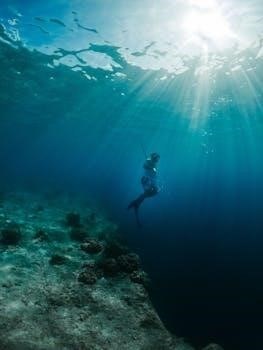
Wetsuit Thickness for Different Activities
Wetsuit thickness selection depends not only on water temperature but also on the specific activity. Scuba diving and other water sports may necessitate different thicknesses for optimal comfort and safety.
Scuba Diving Considerations
For scuba diving, selecting the correct wetsuit thickness is vital for thermal protection and comfort during extended underwater time. Unlike some other water activities, divers are often submerged for longer periods, making insulation paramount. In tropical waters, a thin wetsuit, like a 2mm shorty or even a rash guard, may be sufficient. However, as water temperatures decrease, thicker suits become necessary. A 3mm full suit is often suitable for slightly cooler waters. For cold water diving, 5mm or 7mm suits are often used, sometimes paired with a hooded vest for extra warmth. The goal is to maintain a comfortable core temperature, preventing hypothermia. The type of dive, depth, and duration must also be considered when selecting the appropriate thickness; It’s also important to consider personal tolerance to cold as some people feel the cold more intensely than others.
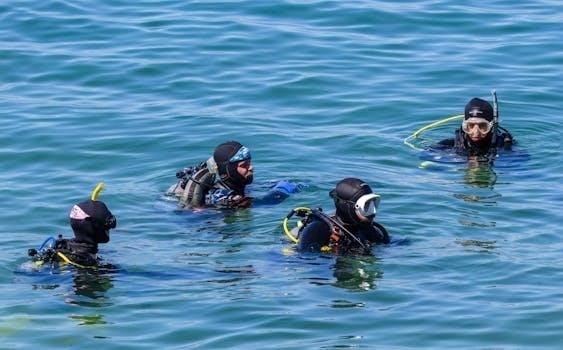
Common Wetsuit Thicknesses
Wetsuits come in various thicknesses, with 3mm, 5mm, and 7mm being the most common. These thicknesses cater to different water temperatures, providing varying degrees of insulation for divers.
3mm Wetsuits
3mm wetsuits are a popular choice for divers venturing into warmer waters, particularly in tropical locations. These suits are ideal for environments like the Maldives, Sri Lanka, Indonesia, and Hawaii, where water temperatures typically remain above 22°C (71.6°F). The 3mm thickness offers a good balance between flexibility and thermal protection, making it comfortable for extended dives in these conditions. Often considered a standard for many divers, a 3mm wetsuit provides sufficient insulation without being too restrictive, allowing for ease of movement underwater. Furthermore, it is a versatile option suitable for various activities beyond scuba diving, such as snorkeling and other water sports. The 3mm wetsuit is also a good starting point for those new to diving, providing a comfortable and manageable experience in warmer climates. While it may not be enough for colder waters, its versatility and comfort make it a staple for many divers.
5mm Wetsuits
5mm wetsuits are designed for cooler water conditions, providing a step up in thermal protection compared to 3mm suits. These suits are suitable for water temperatures ranging from 17°C to 21°C (62.6°F to 69.8°F), making them ideal for diving in temperate regions or during transitional seasons. The 5mm thickness offers a good compromise between warmth and flexibility, allowing divers to stay comfortable without sacrificing mobility. Often overlooked in favor of 3mm or 7mm suits, the 5mm option is perfect for those who find 7mm too warm and 3mm too cold. They are a versatile choice for divers who experience varying water temperatures and provides a comfortable option during transitional seasons. The 5mm wetsuit ensures a good balance of warmth and flexibility, making it a valuable addition to a diver’s gear.
7mm Wetsuits and Above
7mm wetsuits and those thicker are designed for cold water diving, providing maximum thermal protection in temperatures below 17°C (62.6°F). These suits, often paired with accessories like hooded vests, offer enhanced insulation to maintain body heat in challenging conditions. Divers in these temperatures typically require the substantial warmth offered by 7mm or even 8/7mm semi-dry suits. These thicker suits are essential for extended dives in cold waters, and when paired with appropriate accessories, they provide the necessary protection to stay comfortable and safe. For extremely cold conditions, divers may choose a drysuit for even greater insulation. The use of 7mm wetsuits and above is critical for divers who require maximum protection from the cold, ensuring they can explore diverse underwater environments comfortably and safely.